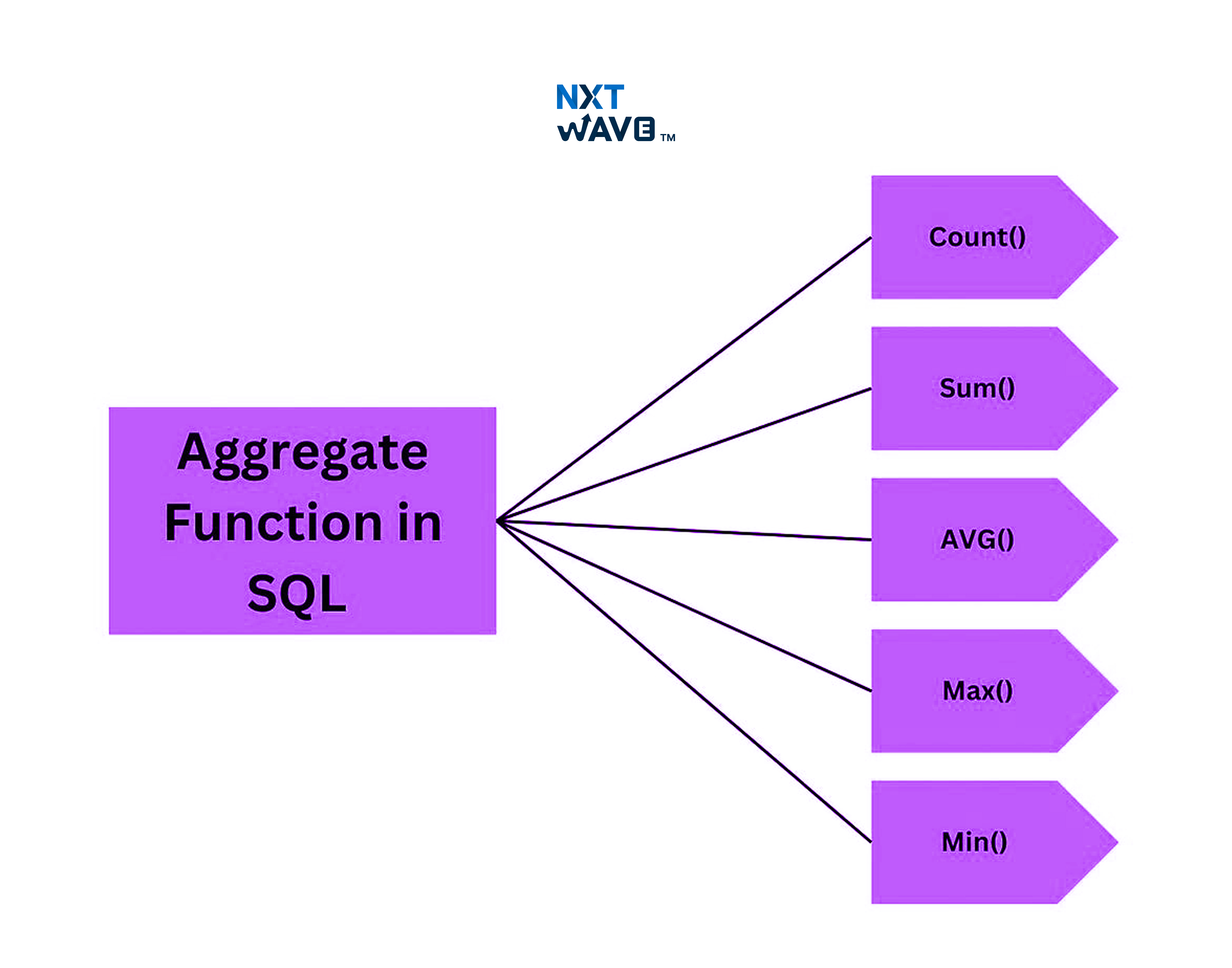Aggregate functions in DBMS are crucial in helping to summarise and analyze data. These functions process multiple rows of data and return a single value representing a summary, making it easier to interpret large datasets and make informed decisions. In this guide, you will learn what aggregate functions are, the types available, their real-world applications, and how they are used in SQL queries to extract meaningful insights from data.
Introduction to Aggregate Functions
Aggregate functions in DBMS help process multiple values from a set of data to generate a single summarized result. These functions are essential for analyzing large datasets, making it easier to draw meaningful insights. Common aggregate operators in DBMS are: COUNT, SUM, AVG (average), MIN (minimum), and MAX (maximum).
These functions are used in SQL queries for reporting, trend analysis, and decision-making. Whether you're calculating total sales, finding the highest score, or counting the number of users aggregate in DBMS simplifies complex data processing.
Characteristics of Aggregate Functions
Aggregate operators in DBMS are essential tools in data analysis because they help summarize and process large amounts of information efficiently. Here’s what makes them valuable:
- Work on Multiple Rows: Instead of analyzing data row by row, aggregate in DBMS take a group of rows and performs calculations on them. This is useful for tasks like finding totals, averages, or counts.
- Produce a Single Result: No matter how many rows are involved, these functions always return a single value. This makes interpreting and comparing data easier without dealing with multiple individual results.
- Used with GROUP BY: When you need to categorize data based on specific attributes (such as sales per region or average salary by department), the GROUP BY clause is used alongside aggregate functions to organize and analyze the information effectively.
Types of Aggregate Functions
Aggregate functions in DBMS perform calculations on multiple rows and return a single result. Here are some of the most commonly used ones:
1. COUNT (Counting Rows)
The COUNT function, a fundamental part of SQL aggregate functions in DBMS, counts the number of rows in a table or the number of non-null values in a column.
Example
SELECT COUNT(*) FROM Employees;
Output
COUNT(*)
50
This means there are 50 rows (employees) in the Employees table.
2. SUM (Total Sum of Values)
The SUM function adds up all numeric values in a specified column.
Example
SELECT SUM(salary) FROM Employees;
Output
SUM(salary)
5,000,000
This means the total salary paid to all employees is 5,000,000 (currency depends on your database).
3. AVG (Calculating the Average)
The AVG function calculates the average value in a numeric column, making it one of the essential SQL aggregate functions in DBMS for data analysis.
Example
SELECT AVG(salary) FROM Employees;
Output
AVG(salary)
100,000
This means the average salary of employees is 100,000.
4. MIN (Finding the Minimum Value)
The MIN function retrieves the smallest value in a column.
Example
SELECT MIN(salary) FROM Employees;
Output (Example Data)
MIN(salary)
40,000
This means the lowest salary in the company is 40,000.
5. MAX (Finding the Maximum Value)
The MAX function in SQL aggregate functions in DBMS retrieves the highest value in a column.
Example
SELECT MAX(salary) FROM Employees;
Output
MAX(salary)
300,000
This means the highest salary among employees is 300,000.
Using Aggregate Functions with GROUP BY
The GROUP BY clause is essential when using aggregate functions in DBMS because it groups rows that have the same value in a specified column. Instead of calculating results for the entire table, it performs an aggregate in DBMS, which involves the operations for each group separately.
Code Example: Finding the Highest Salary by Department
The following query retrieves the highest salary in each department:
SELECT department_id, MAX(salary)
FROM Employees
GROUP BY department_id;
Example Output
| department_id |
MAX(salary) |
| 1 |
150,000 |
| 2 |
120,000 |
| 3 |
180,000 |
| 4 |
95,000 |
Result Analysis
- In Department 1, the highest salary is 150,000.
- In Department 2, it's 120,000, and so on.
How GROUP BY Works with Aggregate Functions?
The GROUP BY department_id ensures that employees are grouped by department. The MAX(salary) function is then applied within each department, rather than across the whole table.
The HAVING Clause in Aggregate Functions
The HAVING clause is used to filter grouped results based on aggregate functions in DBMS. It works similarly to the WHERE clause, but instead of filtering individual rows, it applies conditions after the aggregation has been performed.
Code Example: Departments with Total Sales Exceeding $1000
SELECT department_id, SUM(sales_amount) AS total_sales
FROM Sales
GROUP BY department_id
HAVING SUM(sales_amount) > 1000;
Example Output
| department_id |
total_sales |
| 101 |
5,000 |
| 102 |
2,500 |
| 104 |
3,200 |
Result Analysis
This means only departments 101, 102, and 104 had total sales exceeding $1000, while others were filtered out.
How HAVING Clause Work with Aggregate Functions?
The query groups sales data by department_id and uses aggregate operators in DBMS to summarize the data. It calculates the total sales for each department using SUM(sales_amount). The HAVING clause then filters out departments where total sales are $1000 or less.
How To Use Aggregate Functions In SQL?
Let's say we have a table called Employees with details about employee ID, name, department, and salary. We can use aggregate functions in DBMS to analyze this data, such as calculating the total salary paid to employees in each department or finding the highest salary in the company.
Sample Data: Employees
| EmployeeID |
Name |
Department |
Salary |
| 1 |
John Smith |
Sales |
50000 |
| 2 |
Jane Doe |
Marketing |
60000 |
| 3 |
Mike Brown |
Sales |
55000 |
| 4 |
Emily Lee |
Marketing |
65000 |
| 5 |
David Kim |
IT |
70000 |
SQL Query Using Aggregate Functions
The purpose is to calculate the total salary, average salary, minimum salary, and maximum salary for each department.
SELECT
Department,
COUNT(*) AS EmployeeCount,
SUM(Salary) AS TotalSalary,
AVG(Salary) AS AverageSalary,
MIN(Salary) AS MinSalary,
MAX(Salary) AS MaxSalary
FROM
Employees
GROUP BY
Department;
Explanation
- COUNT(*): Counts the employees in each department.
- SUM(Salary): Adds up all salaries in each department.
- AVG(Salary): Finds the average salary per department.
- MIN(Salary) & MAX(Salary): Identify the lowest and highest salaries in each department.
Output
| Department |
EmployeeCount |
TotalSalary |
Average Salary |
MinSalary |
MaxSalary |
| IT |
1 |
70000 |
70000.00 |
70000 |
70000 |
| Marketing |
2 |
125000 |
62500.00 |
60000 |
65000 |
| Sales |
2 |
105000 |
52500.00 |
50000 |
55000 |
Time and Space Complexity
- Time Complexity: O(N), where N is the number of employees.
- Space Complexity: O(D), where D is the number of unique departments.
Advanced SQL Concepts
1. Conditional Aggregation
You can apply conditions within an aggregate in DBMS to focus on specific data.
Example: Calculating total sales for a specific product
SELECT SUM(sales_amount)
FROM Sales
WHERE product_id = 101;
2. Nested Aggregations
Sometimes, you need to perform multiple levels of aggregation for deeper analysis.
Example: Finding departments where the average salary is above a certain amount
SELECT department_id, AVG(salary) AS average_salary
FROM Employees
GROUP BY department_id
HAVING AVG(salary) > 50000;
Applications of Aggregate Functions
1. Summarizing Data
Aggregate functions in DBMS help in reducing large datasets into meaningful summaries. For example, businesses use them to calculate total sales revenue or assess employee performance by analyzing completed tasks, customer ratings, or productivity scores.
2. Statistical Analysis
These functions are essential for calculating averages, medians, and standard deviations, making it easier to identify patterns. Businesses can track trends over different periods, such as seasonal demand changes or long-term sales growth.
3. Reporting
Companies depend on aggregate in DBMS to generate reports that support decision-making. Summary reports and dashboards provide essential performance indicators (KPIs), such as profit margins, customer retention rates, and operational efficiency.
4. Improving Performance
Aggregate functions in DBMS reduce the need for processing large volumes of raw data by summarizing data at the database level. Caching frequently used results further improves system performance, resulting in faster query execution and reduced server load.
Advantages of Using Aggregate Functions
1. Efficiency
Aggregate in DBMS process calculations directly within the database, reducing the need for additional computations in applications. This minimizes computational overhead and speeds up data retrieval, making queries more efficient.
2. Scalability
These functions can handle large datasets efficiently, allowing businesses to analyze millions of records without performance issues. By summarizing data before retrieval, they help maintain smooth operations even as data volume grows.
3. Simplicity
Using aggregate functions in DBMS simplifies complex queries by reducing multiple operations into a single SQL statement. This makes database queries easier to write, read, and maintain, reducing the chances of errors and improving productivity.
Conclusion
Aggregate functions in DBMS simplify data analysis, summarization, and reporting. They allow businesses to efficiently process large datasets, extract meaningful insights, and optimize performance. By using functions like COUNT, SUM, AVG, MIN, and MAX, organizations can streamline decision-making and enhance operational efficiency. These functions not only improve query execution speed but also help in creating structured reports and trend analyses. Overall, aggregate operators in DBMS are essential for handling complex data processing tasks in a scalable and effective manner.
Frequently Asked Questions
1. What are aggregate functions in DBMS?
Aggregate functions are built-in operations that process a group of values and return a single result. Examples include SUM, AVG, COUNT, MIN, and MAX. These functions help in summarizing data, making them useful for reports and data analysis.
2. How do aggregate functions differ from regular queries?
Regular queries fetch raw data directly from the database, while aggregate functions translate that data. For example, a regular query may show all employee salaries, whereas an aggregate function can calculate the total salary paid to all employees.
3. How do aggregate functions work with the GROUP BY clause?
The GROUP BY clause groups data based on a specific column and applies an aggregate function to each group. For example, GROUP BY department_id with SUM(salary) calculates the total salary for each department instead of the entire company.
4. Do aggregate functions consider NULL values?
Most aggregate functions ignore NULL values. For example, SUM and AVG only use non-null values. However, COUNT(*) includes all rows, whether they contain NULL values or not.
5. What are some common uses of aggregate functions?
Aggregate functions are essential for reports, trend analysis, and decision-making. They are used for:
- Calculating total revenue (SUM)
- Finding the average salary of employees (AVG)
- Identifying the highest or lowest values (MAX, MIN)
- Counting the number of records in a table (COUNT)
6. Can aggregate functions be used in non-relational databases?
Yes! While SQL databases have built-in aggregate functions, non-relational databases also deliver similar ways to summarize and analyze data using their query languages.
7. What are some advanced features of aggregate functions?
Some advanced uses include:
- Conditional Aggregation: Summing only values that meet certain conditions (e.g., sales above a specific amount).
- Nested Aggregations: Using one aggregate function inside another for more in-depth analysis.
- Window Functions: Performing calculations across a set of rows while keeping individual row details intact.







.avif)














